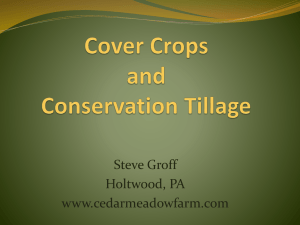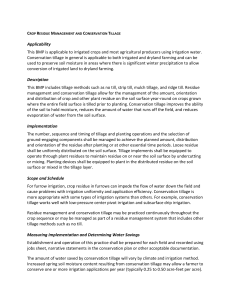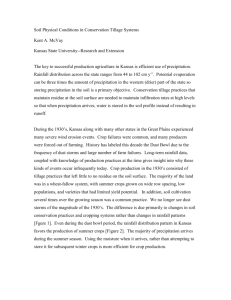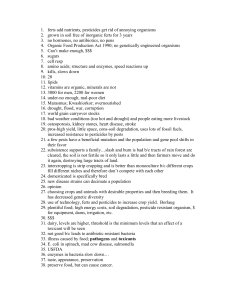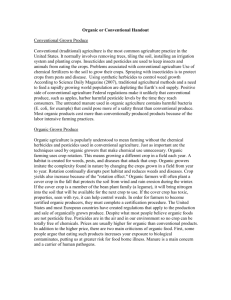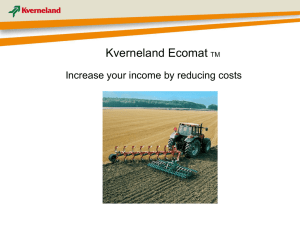On-Farm Zone Tillage Vegetable Trials in NY Funding through NY
advertisement
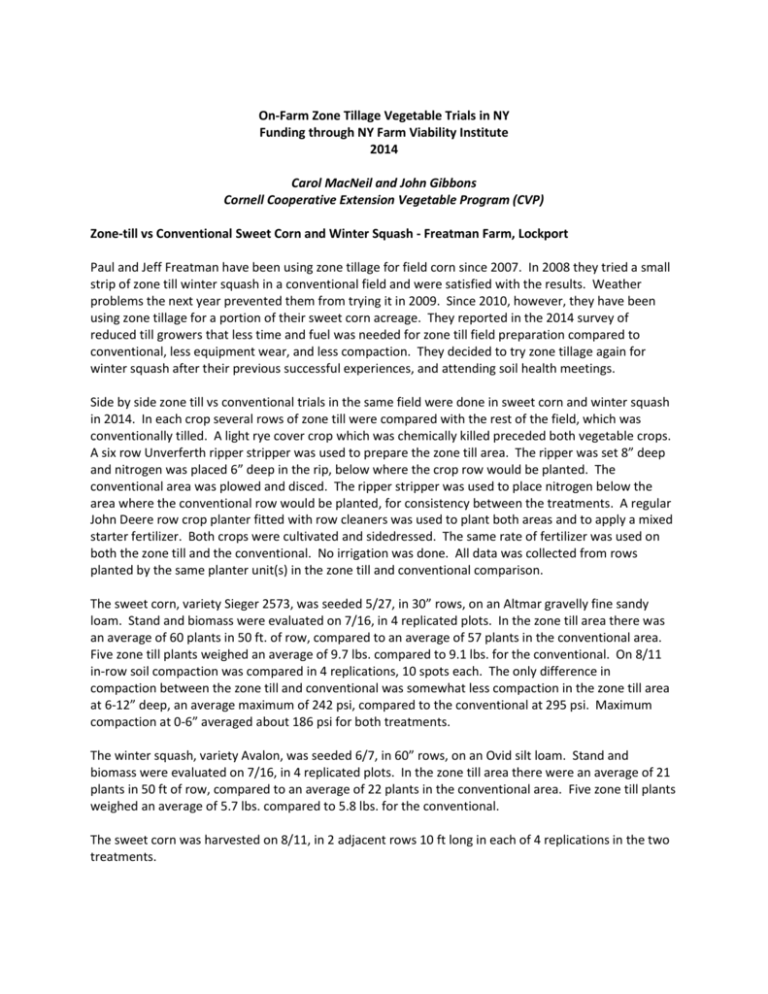
On-Farm Zone Tillage Vegetable Trials in NY Funding through NY Farm Viability Institute 2014 Carol MacNeil and John Gibbons Cornell Cooperative Extension Vegetable Program (CVP) Zone-till vs Conventional Sweet Corn and Winter Squash - Freatman Farm, Lockport Paul and Jeff Freatman have been using zone tillage for field corn since 2007. In 2008 they tried a small strip of zone till winter squash in a conventional field and were satisfied with the results. Weather problems the next year prevented them from trying it in 2009. Since 2010, however, they have been using zone tillage for a portion of their sweet corn acreage. They reported in the 2014 survey of reduced till growers that less time and fuel was needed for zone till field preparation compared to conventional, less equipment wear, and less compaction. They decided to try zone tillage again for winter squash after their previous successful experiences, and attending soil health meetings. Side by side zone till vs conventional trials in the same field were done in sweet corn and winter squash in 2014. In each crop several rows of zone till were compared with the rest of the field, which was conventionally tilled. A light rye cover crop which was chemically killed preceded both vegetable crops. A six row Unverferth ripper stripper was used to prepare the zone till area. The ripper was set 8” deep and nitrogen was placed 6” deep in the rip, below where the crop row would be planted. The conventional area was plowed and disced. The ripper stripper was used to place nitrogen below the area where the conventional row would be planted, for consistency between the treatments. A regular John Deere row crop planter fitted with row cleaners was used to plant both areas and to apply a mixed starter fertilizer. Both crops were cultivated and sidedressed. The same rate of fertilizer was used on both the zone till and the conventional. No irrigation was done. All data was collected from rows planted by the same planter unit(s) in the zone till and conventional comparison. The sweet corn, variety Sieger 2573, was seeded 5/27, in 30” rows, on an Altmar gravelly fine sandy loam. Stand and biomass were evaluated on 7/16, in 4 replicated plots. In the zone till area there was an average of 60 plants in 50 ft. of row, compared to an average of 57 plants in the conventional area. Five zone till plants weighed an average of 9.7 lbs. compared to 9.1 lbs. for the conventional. On 8/11 in-row soil compaction was compared in 4 replications, 10 spots each. The only difference in compaction between the zone till and conventional was somewhat less compaction in the zone till area at 6-12” deep, an average maximum of 242 psi, compared to the conventional at 295 psi. Maximum compaction at 0-6” averaged about 186 psi for both treatments. The winter squash, variety Avalon, was seeded 6/7, in 60” rows, on an Ovid silt loam. Stand and biomass were evaluated on 7/16, in 4 replicated plots. In the zone till area there were an average of 21 plants in 50 ft of row, compared to an average of 22 plants in the conventional area. Five zone till plants weighed an average of 5.7 lbs. compared to 5.8 lbs. for the conventional. The sweet corn was harvested on 8/11, in 2 adjacent rows 10 ft long in each of 4 replications in the two treatments. Hand harvested yield of sweet corn/plot Zone Till Conventional # Plants/ plot # Total ears # Mktble ears Total wt. (lbs) Mktble wt. (lbs) 24 34 34 26 25 24.4 22.9 19.9 17.8 23 *Most unmarketable ears were too small The squash was harvested on 9/10, in 2 rows 20 ft long, in each of 4 replications. Hand harvested yield of winter squash/plot # Plants/ plot # Total fruit # Mktble fruit Total wt. (lbs) Mktble wt. (lbs) 12 Zone Till 43 41 186 175 Conventional 8 41 38 174 172 *Most unmarketable fruit were misshapen or had external defects The grower had the same harvest results in sweet corn and winter squash, with no difference in yield between zone till and conventional treatments. No differences were observed in rainfall percolation or weed pressure. Zone tillage for winter squash will be tried again in 2015, and will be continued for sweet corn. A concern of many zone till vegetable growers is weed control. Kill of red cover and annual ryegrass cover crops in the spring is not reliable. Reliable annual ryegrass kill is a concern for field crops growers, as well, both in and outside of NYS. Annual weed control in vegetables can also be a problem with zone tillage. There is often a few week period when there is no weed control in zone till fields, between cover crop burn down and the crop’s first herbicide with postemergence activity. The weeds that germinate and begin to grow during this time may be too large to control by the time of cultivation or application of a postemergence herbicide safe for the crop. Most vegetable preemergence herbicides do not have postemergence activity, though some do. Thus choice of herbicides is critical in zone till vegetables. Freatman’s use Sandea preemergence in winter squash right after planting and this material has both pre and postemergence activity, so most annual broadleaf weeds were controlled. Cultivation takes care of the few escapes. Their sweet corn market will not accept Roundup-Ready sweet corn in 2015 so an herbicide with both pre and postemergence activity, like atrazine, will be needed right after planting next year. Freatman’s Unverferth ripper stripper, showing cutting disc, ripper, coulters and basket Conventional squash hills Zone till squash hills Conventional squash fruit Zone till squash fruit Zone-till Cabbage - Brightly Farm, Hamlin, 2014 Joe Brightly started growing zone till cabbage a few years ago, after growing field crops and winter squash zone till for several years. He didn’t feel he needed to compare zone till vs conventional cabbage this year. There are many challenges to growing zone till cabbage. A major one is that the transplanter does not handle moderate to heavy plant residues on the surface. This year his zone till cabbage showed very uneven growth, which didn’t correspond to the planter/ripper row, or the area of the field. There was no pattern in soil compaction in-row that followed the plant growth. Cabbage requires high rates of fertilizer, especially potassium, which is a challenge to apply when fertilizer is not broadcast and worked in with conventional tillage. It is speculated that the rate of fertilizer applied in the transplant water may have been too high. In his fifth full year of zone tillage, Joe has seen the most change in his soil compared to other years. He has observed effects of mellow soil, better water movement and water retention, firm on top and full of air in the bottom. He has drastically reduced the baseball-size soil clumps that he would occasionally see with full width tillage and drastically reduced crusting. As for crop growth he has seen no yield drag with vegetables. He does not attribute this cannot solely to strip tillage, but regardless, he points out that he is saving a good amount of money due to less fuel and equipment wear per acre. As for our nutrition program, he is broadcasting potash and lime and everything else is banded into the root zone where the plant needs it. He estimates a 15 percent savings in fertilizer efficiency. The biggest takeaways Uneven growth in zone till cabbage 2014 Soil Health Workshop - Branton Farm, Stafford, August 19, 2014, 3:00 – 8:00 pm The objective of this on-farm event was for growers to gain a better understanding of the importance of good soil health, and the benefit of reducing tillage and increasing use of cover crops. Over 200 growers and farm service providers attended. Carol MacNeil served on the planning committee along with local growers, and NRCS and SWCD staff. Zone and no-till equipment, and cover crop drills and interseeders, were on display. There was a panel of growers who described their good soil management practices including reduced tillage, cover cropping, and good crop rotations. Casey Kunes, Hemdale Farms, Seneca Castle, one of the first farms in NYS to adopt large scale use of zone till for cabbage, in addition to field crops and squash, was invited to participate. A former NRCS soil scientist, Frank Gibbs, Wetland & Soil Consulting Services, Rawson, Ohio, spoke on the benefit of earthworms. A long time no till/cover cropping grower, Eric Kaiser, Kaiser Lake Farms, Napanee, Ontario, Canada, spoke on no tilling on a heavy soil in a northern climate. A soil pit on Donn Branton’s farm, with a long history of reduced tillage and cover crops, revealed a high population of earthworms and their channels. Carol MacNeil spoke on the Cornell Soil Health Test, showing the good results for a soil with good management (reduced tillage, good rotation), vs the poor results for a soil with poor management (conventional tillage, more intensive cropping). Earthworm channels in a zone/no-till soil Sandra Menasha Cornell Cooperative Extension Suffolk County Zone-till vs. Conventional Squash, Zone till Cucumber and Zucchini – Zaweski, Riverhead Mark Zaweski trialed reduced tillage in the past, 2014 was the 3rd season. His motivation for the trial this year was to further evaluate the effectiveness of the practice. He is considering buying his own equipment but wanted more information/experience. Kabocha squash was trialed this year. A side by side comparison of the two tillage practices, conventional and reduced till, was established on one field. He also trialed reduced tillage in his entire cucumber and zucchini crop. Results from the Kabocha squash trial Treatment Fruit # Fruit Wt. (lbs) Conventional 5.2 19.4 Reduced Till 6.0 18.8 Avg Wt./Fruit 3.8 3.1 In his squash, Mark did not observe any differences in drainage but it was an incredibly dry season. Weed pressure was slightly greater in the RT half of field and crop plants were smaller. He observed less fruit in conventional but it was larger and heavier and he know that’s what the buyer is looking for. Overall it worked well. In the cucumber and zucchini RT field, weeds were a major concern! Yellow marsh cress took over the field. He had never seen this weed before and it was never a concern but it took over the field, made picking extremely difficult, and yields were reduced as a result. A lot more management was required to mow row centers to keep it at bay but this was not possible once vining occurred. He found he had to give up a planting. Another challenge is knowing and deciding when best to kill the cover crop (rye in most cases). If it is killed when very young, weed pressure builds over the course of the season. If it is left to get too big, it could be trouble getting the rye to lay down and also could be a hazard to workers (i.e. sharp rye stalks sticking up, poked in the eye). Mark is still consider adopting RT on the farm. He sees the labor saving potential once all the kinks get worked out as well as the soil health improvement opportunities, especially how it relates to reducing phytophthora – present on several of his farm fields. Weed control is the biggest barrier to fully adopting its use. New weeds emerge and there are very limited options in Long Island that can be used for control and likely more will be removed from the market in the future. Ryan Maher Cornell Vegetable Program, Ithaca Campus Zone-till vs Conventional Pumpkins - Reisenger Apple Country, Watkins Glen Rick Reisenger trialed deep zone tillage for the 1st year after learning about successful zone tilled pumpkins at the winter NY vegetable meeting. He compared deep zone and conventional tillage within a Cronus pumpkin crop planted at two different row spacings, single and double row. Each treatment was a ½ acre strip in a field where the previous crop was soybean. Soils were a Mardin silt loam. Rick borrowed the project’s Unverferth Zonebuilder (2 row), tilled and direct seeded pumpkins in early June. His conventional treatment was moldboard plowed, disked, and planted at the same time. This trial also looked at the effect of plant spacing in each tillage treatment. In half of the treatment, he seeded both rows at 30 in spacing and increased the in-row spacing to 8 ft. Single rows were planted at 4 ft in-row. Regardless, plant populations were maintained at 32 square feet per plant with 8 ft centers. Fruit weight and diameter were similar across tillage treatments with the greatest difference in the single-row conventional strip. This treatment had 25% greater yield and significantly less weed pressure. Observed weed density was not related to tillage or plant spacing, but likely driven by other unknown factors. For weed control, he applied pre-emergent herbicide (Sandea and Strategy) to the entire field within the first 2 days of planting but there was still heavy weed pressure in many areas. Overall, Rick was satisfied with yields although this was only the first year growing the Cronus variety. Tillage Deep Zone Deep Zone Conventional Conventional Plant Spacing Single-Row Double-Row Single-Row Double-Row Ave Fruit Weight (lbs) 25.2 21.9 33.7 25.8 Ave Fruit Dia (in) 13.6 13.2 15.8 13.4 Rick faced unexpected challenges operating the zone till unit this field because of soybean residue and rocky soil. The unit had difficulty preparing a seedbed within windrows of residue left by the combine and this required more troubleshooting time and labor than anticipated. He made several passes with the unit to prepare the planting row adequately for his planter. After this experience and learning the time invested in setup and coordination, Rick is not planning to trial zone tillage in the near future but remains interested in the approach. Zone-till Acorn squash - Catskill Fresh, Deposit, NY Lonny Schaefer compared acorn squash production in zone tillage with two different cover crops. Lonny has been increasingly interested in cover crop mixtures and reducing tillage on his farm while also creating more forage for his beef cattle operation. No-till sweet corn has been a part of his operation for many years. He sees a market opportunity to increase pumpkin and winter squash acreage and would like to incorporate cover crops more effectively in the rotation. After attending a winter meeting and presentation on zone tillage, Lonny acquired a custom-built, one-row zone builder. Lonny planted strips of two different cover crop mixtures in the fall of 2013, winter rye and crimson clover/oats/winter peas/forage radish. The field had been in sweet corn the previous year and was a Riverhead loam soil. The crimson clover and peas overwintered and regrowth was chopped and baled in early June. Winter rye was also chopped and removed. After zone building into the residue, acorn squash was direct seeded and observations were made on weeds and acorn yield. Stands of both cover crops were highly variable. Based on observed weed pressure, winter rye was less effective at controlling early season weeds. The rye was likely not planted at a high enough density to compete. In comparison, the clover and pea mixture was highly productive and provided a very good forage crop. Lonny did not observe a squash yield difference when comparing the two cover crops plantings. Both were lower than expected, fewer fruits per plant compared to previous years. This was attributed to a cool, wet spring and subsequent late planting and unexpected deer herbivory. Lonny will continue to trial zone tillage in his vegetable crops and integrate different cover crops. In winter squash, he would like to plant a cover crop and manage the inter-row spacing with a mower or flail chopper. Based on experience this year, he found that even in his bush varieties, he would need to increase row spacing to accommodate the mowing unit in the future. A zone tillage trial may include rye or triticale with red clover, planted to winter squash with a wide spacing (up to 10-12 ft). There also is interest in incorporating different legume cover crops in his no-till sweet corn, either winter-killed field peas/oats for early plantings or winter peas/oats/crimson clover for a spring forage harvest and late planting. Amy Ivy and Peter Hagar Cornell Cooperative Extension, Clinton County Growers in NNY trialed our customized 2 row zone-builder, built from a Yeomans plow with an added finishing unit in a previous year. Educators coordinated the sharing of this equipment among growers and were faced with many challenges to establish a successful trial. As we have found in our earlier work, the primary obstacles were 1) coordinating the delivery of the implement at the time of grower need and 2) ensuring each grower had the tractor capacity to operate the zone builder. Although this unit was designed for less horsepower per shank, small growers often still don’t have the capacity to operate the equipment with their tractor. In some cases, an additional level of coordination was required to borrow a tractor from a neighbor. Weather conditions and planting schedules have always created management challenges for equipment sharing, but an effort was made to have interested growers’ trial the equipment in varying capacities, even if not using the equipment as initially planned. Zone-till Sweet Corn and Tomatoes - Lamoy’s Produce, Morrisonville, NY Doug Lamoy farms 50 crop acres, including sweet corn, tomatoes, cucumbers, squash and cabbage He had never trial zone tillage but has had an interest in reducing compaction and increase drainage capacity on the farm. His sees the primary concern as managing weeds in this system. The zone till unit was trialed in both his sweet corn and tomato crops. He did not have a conventional tillage comparison within the field. It was difficult to observe the effect of zone tillage on field drainage, especially because of last year’s exceedingly wet conditions. He found it challenging to get the equipment in a timely way and then to handle the different spacing of the zone-till unit and his own planter. These challenges will make it unlikely that he will try zone tillage next year. Zone-till to Reduce Compaction - Rehoboth Homestead, Peru, NY Beth Spaugh manages 3.5 crop acres, 3 acres of pasture, and 1.5 acres of perennials. Her primary vegetable crops include tomatoes, peppers, cabbage, broccoli, and greens. She had tried zone tillage in the past but found it difficult to manage in her heavy soils and has concerns with managing weeds and irrigation in a zone-till crop. However, her goal is to reduce rototilling on the farm and recognizes that a plow pan has developed. After attending our summer field day, she decided to use the unit in the fall to break up these layers of subsoil compaction. For her small operation, it was a challenge to coordinate the use of the equipment on her farm. She needed to custom-hire a tractor, which was an added expense. She is very interested in future management options with the zone builder but without a large enough tractor, the timing and coordination of a custom hire will be complicated. She see an opportunity to spread compost prior to using the zone builder as another way to amend and improve her soils. Zone-till Pumpkins - Country Dreams Farm, Plattsburgh, NY Melissa Provost manages 40 crop acres with pumpkins and other cucurbits as her primary vegetable crops. She considers zone tillage an opportunity to save labor and improve drainage on the farm. She had never tried zone tillage and has an interest in trying new methods. She planted her entire pumpkin crop into a zone-tilled field and it work very well. The unit tilled and hilled with no challenges and it improved drainage, even on tiled ground. She would like to adopt zone-till practices in the future but sees the availability of equipment as a major barrier. Without equipment to borrow, the cost of a new zone builder is too high for her operation but she has an interest in custom-building a unit for her farm. Zone-till to Reduce Compaction - Tucker Farms, Gabriel NY Tom Tucker manages 400 crop acres, including potatoes, row crops, grains, and vegetables. He had never tried zone tillage and wanted to reduce compaction and improve drainage on the farm. He chose to use the unit mid-season, prior to establishing an oat cover crop, to break up subsoil compaction. He observed that drainage improved and fall rainfall events showed better infiltration. However, it was a difficult to coordinate the delivery of the unit when it was needed. He also observed that the unit pulled up many rocks from the subsoil. In the future, he would consider adopting the practice with the goal of improving drainage and reducing compaction but the expense of buying an implement is too high. Shared equipment is also present challenges, it is not always available and his farm is a distance from other farms.
